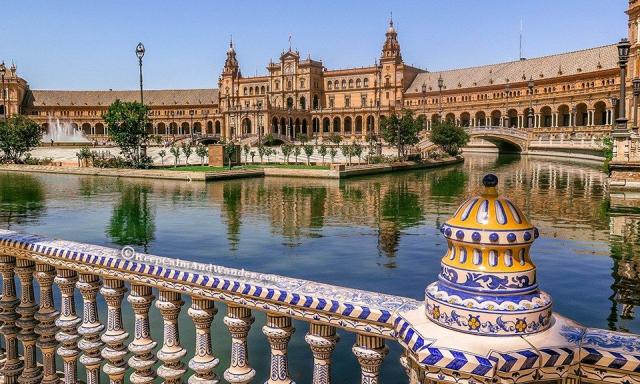The Plaza de España is an architectural complex located in the María Luisa park in the city of Sevilla (Spain).
It was designed by the architect Aníbal González. It was built between 1914 and 1929 as one of the main constructions of the Ibero-American Exposition of 1929.
It constitutes the largest building of all those that were erected in the city during the 20th century, comparable to the other two outstanding historical constructions outside the walls of the city, which are the Hospital de las Cinco Llagas (16th century) and the Royal Tobacco Factory (18th century).
The square has large dimensions (170 meters in diameter) and a semi-elliptical shape, which symbolizes the embrace of Spain to its former American territories, and looks towards the Guadalquivir river, as the way forward to America.
Its total area is approximately 50,000 square meters, of which 19,000 are built and the remaining 31,000 are free space.
It is bordered by a channel that runs for 515 m and is crossed by four bridges.
The buildings that surround the square are structured in a central building, wings with intermediate buildings that compensate for an excessive length and towers at the ends.
The construction is made of exposed brick and has extensive ceramic decoration.
The ceilings of the gallery in the square have wooden coffered ceilings that are supported by marble columns. The backs of the benches and some lampposts are made of wrought iron.
The medallions with effigies of famous Spaniards, the marble columns and the coffered ceilings give the whole a Renaissance atmosphere.
According to the writings of Aníbal González, his inspiration for designing the square had been the Spanish Renaissance, with the Sevillian architect providing it with new modern elements.
The two towers that flank the square, which provide a Baroque-style atmosphere, are 74 meters high.
The central fountain, the work of Vicente Traver, has been highly questioned because it breaks the emptiness of the square. The canal it contains is crossed by 4 bridges that represent the 4 ancient kingdoms of Spain (León, Castilla, Aragon and Navarra).
On the walls of the square there is a series of 48 benches that represent, in alphabetical order, forty-six peninsular Spanish provinces (all except Seville) and the two archipelagos (Canary Islands and Balearic Islands), with their shield, a map and a cloth Pisan tile with outstanding historical facts of that territory.


Leave A Comment